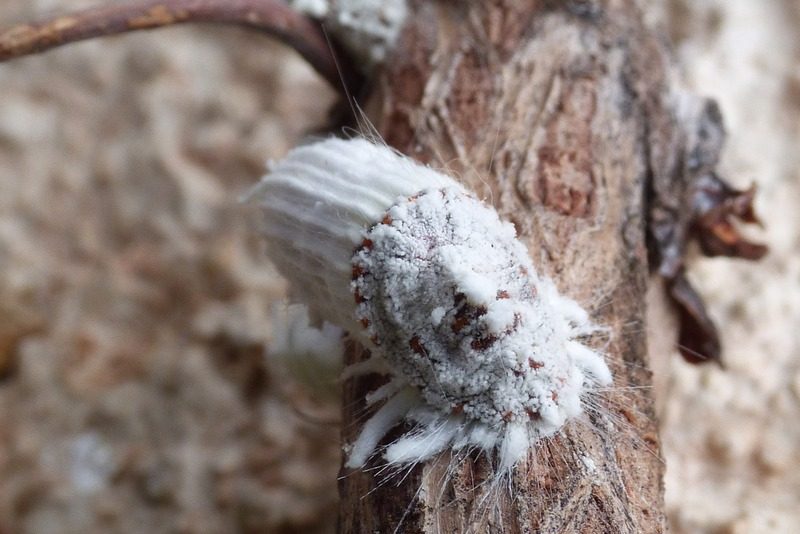You have two methods to learn how to get rid of cottony cushion scale. It can be discouraging to notice these pests in your plants, but take comfort in knowing that you have biological and chemical solutions to address them. However, getting rid of and controlling these pests isn’t enough, and prevention is also necessary.
You can consider growing plants in the greenhouse since it’s more comfortable to prevent bugs indoors. Remember that the easier it is to control the insect population, the quicker it is to eradicate them. And as a bonus, you have control over greenhouse conditions that can keep cottony cushion scales from multiplying rapidly.

How To Control And Remove Cottony Cushion Scale
Method #1. Biological
According to the University of California, you can use the two natural enemies of the cottony cushion scale to your advantage in controlling them. This is an ideal option for those who can’t rely on chemicals to eliminate these insects. You can either use vedalia beetles or parasitic flies.
Vedalia beetle
The former is perhaps the most common biological way to get rid of the cottony cushion scale. These beetles have even proven themselves effective in saving the citrus industry in California back in the 1890s. How do vedalia beetles help you get rid of cottony cushion scale?
Both the larvae and adult beetles will feed on the insects. The mature female beetles even lay the eggs under the female scale, helping control the scale population. And best of all, the beetles will feed on all the life stages of scale.
Parasitic fly
The second natural enemy that you can use to address your scale problem is the parasitic fly. This insect also lays eggs on various scale life stages, including on adult female scales. The adult fly will then emerge from the scale.
Whichever insect you choose, you should be pleased that they have a short generation time. This makes them excellent in controlling cottony cushion scale quickly, without you worrying about other beneficial insects.
Method #2. Chemical
The second method for getting rid of the cottony cushion scale is by using chemicals. However, consider this as your last option to address the pests. Still, there will be instances that one can only control cottony cushion scale using chemicals, so know how to use insecticides properly.
Before anything else, understand that this pest is already difficult to treat compared to others. A sac protects the adult scale and even the eggs, so insecticides can’t contact them as efficiently. Instead, you can use horticultural oil during dormancy to make the control easier.
Chemicals to use and never use
Gardeners also use spray insecticides on the foliage to treat younger scales when the females are already dead. The best time to spray is when the crawlers are hatching, and you can know this timing by placing sticky tape traps to catch these insects. The ideal chemicals would be acephate and organophosphates malathion.
The emphasis is necessary that you can’t use acephate on other plants except for ornamentals. On the other hand, organophosphates malathion can harm other beneficial insects like bees. Therefore, use chemicals with precaution and read their labels diligently.
What chemicals won’t be useful for cottony cushion scale? Imidacloprid doesn’t kill the insects but can harm the beneficial vedalia beetles. More so, you risk having an outbreak after using this insecticide.
Damages Caused By Cottony Cushion Scale
Always be on the lookout for the signs of cottony cushion scale infestation. You will see sooty mold on the foliage and flowers of your plant for starters due to the honeydew they left. This mold will eventually turn black and prevents sunlight absorption.
We all know how sunlight is essential to plants, so receiving under their light requirements will cause problems in the growth and development of young shoots. Therefore, it’s typical to see leaf loss or yellowing foliage when there is a cottony scale infestation on your plants. The University of Arizona recommends monitoring your plants early in spring to address these pests as soon as possible.
More so, remember to do preventative measures year-round to avoid encouraging these pests in your area. Be mindful of the new plants that you bring and the environmental conditions that can support scale. You can use a greenhouse to create a controlled growing area while also practicing sanitation and pruning to manage infestations from becoming heavy.
Conclusion
Cottony cushion scale is one of the most annoying pests to discover in the garden. However, you can learn how to get rid of cottony cushion scale using biological and chemical controls. Still, remember the importance of prevention and get these pests population under control to make treatment more comfortable.
You can take advantage of vedalia beetles and parasitic flies since they are natural enemies of scale. But if the pests’ population is too hard to manage, use chemicals with extreme precaution and diligence. Some pesticides harm beneficial insects, while others are only meant for ornamental plants.
More so, some pesticides will not work efficiently against the cottony cushion scale. Therefore, aim to maintain a stable environment that is not supportive of infestation. Practice proper cleanliness to avoid bringing pests into the garden.
